Accepted Scientific Name: Washingtonia robusta H.Wendl.
Berliner Allg. Gartenzeitung 2: 198 (1883)
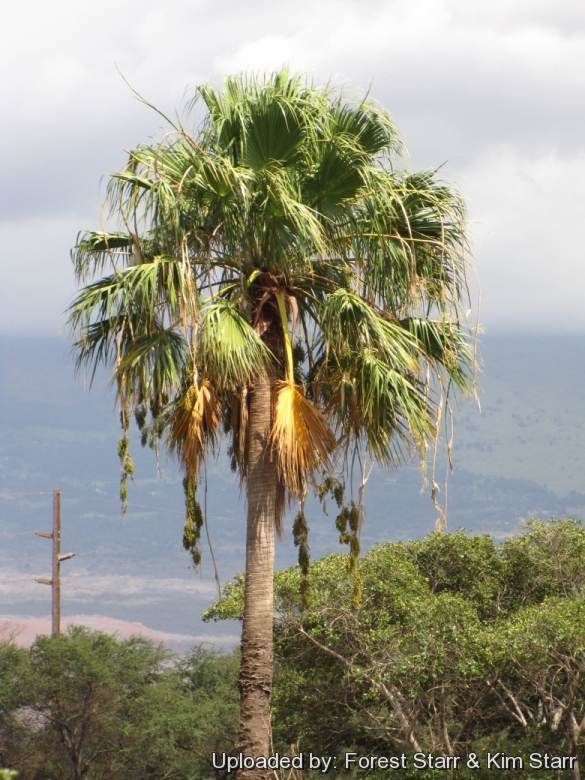
Neowashingtonia robusta (Washingtonia robusta) Photo by: Forest Starr & Kim Starr
Fruiting habit at Kealia Pond NWR, Maui, Hawaii (USA). June 17, 2013.
Origin and Habitat: Mexico (Sonora and Baja California Sur), naturalized and widely cultivated in South United state (California, Florida and Arizona) in areas where it is hardy throughout the world.
Habitat: This palm is native to the desert mountain valleys, canyons and washes where underground water is continuously available. It is naturalized in disturbed areas with moderate rainfall.
Synonyms:
See all synonyms of Washingtonia robusta
back
Accepted name in llifle Database:Washingtonia robusta H.Wendl.Berliner Allg. Gartenzeitung 2: 198 (1883)Synonymy: 10
back
Common Names include:
ENGLISH: Petticoat Palm, Skyduster palm, Thread palm, Mexican washingtonia, Mexican fan palm
ARABIC ( لعربية ): واشنطونيا متينة
CHINESE (中文): Zhuang gan zong lü (Taiwan), Hua sheng dun zong, Hua sheng dun kui (Hong Kong), Guang ye jia zhou pu kui
FRENCH (Français): Palmier évantail du Méxique
GERMAN (Deutsch): Petticoat-Palme, Priesterpalme, Washingtonie, Mexikanische Washingtonpalme
HEBREW (עברית): וושינגטוניה חסונה
ITALIAN (Italiano): Palma messicana
JAPANESE (日本語): ワシントンヤシモドキ, Washinton yashi modoki, Onijuro
NORWEGIAN (Bokmål): Meksikansk viftepalme, Trådpalme
RUSSIAN (Русский): Vashingtonia moshchnaia, Вашингтония нитеносная разн. мощная
SPANISH (Español): Palmera de abanico mexicana, Palmera de abanico
Description: Washingtonia robusta is a massive and majestic palm, easily recognized through its characteristics solid trunk and crown and one of the most widespread of all ornamental plants. It is relative to Washingtonia filifera and can hybridize with it.
Trunk: Solitary, more slender than Washingtonia filifera, usually less than 25 m tall, but soaring up to 30 m in ideal moisture and microclimate conditions and 25-50 cm in diameter, bulging at the ground and becoming slender as it approaches to the crown, grey, ringed with closely set leaf scars although, usually at least part of the trunk, remains covered with dead fronds that remain attached and drop down to cloak the trunk in a wide continuous thatch called a “shag” from the crown all the way to the ground, giving it the common name of Petticoat Palm.
Roots: Fibrous and shallow.
Crown: The canopy is round, symmetrical, loose and open with up to 30 laves (fronds), with a spread of 4,5 m.
Laves(fronds): Alternate, evergreen, costapalmate (fan-shaped) approx 150 cm long and 120 cm across with gracefully drooping leaflet tips; leaflets lanceolate, rich glossy green, 1 metres long, margin entire with long thread-like white cotton-like fibres, between the segments persisting even when the palm is mature. The individual leaflets are pendulous and swing freely in the wind; leaf stems (petiole) about 90-100 cm long, orange, armed along the margins with vicious sawtooth thorns. The leaf-stalks forms a characteristic criss-cross pattern unless removed.
Flowers: The large branched inflorescence extend past the leaves and is 2-3 m long, and holds clusters with numerous small light beige to pale orange-pink flowers. Flowers are bisexual. Ovary 3-lobed.
Blooming season: Late spring to early summer
Fruit: Spherical, blue-black drupe, 6–8 mm diameter; it is edible, though thin-fleshed.
Chromosome number: 2n = 36.
Notes: Washingtonia robustaSN|24741]]SN|24753]] and Washingtonia filiferaSN|24741]]SN|24741]] are closely related and quite similar. They differ in subtle characteristics, and even palm experts have trouble telling them apart. As a general rule the California Washingtonia (Washingtonia filiferaSN|24741]]SN|24741]]) is very similar but has a stockier, more massive and shorter trunk and is said to be more cold tolerant. The name “robusta” is used because this species grows more rapidly in height than Washingtonia filiferaSN|24753]]SN|24741]]. And also W. robusta lacks the persistent cottony threads on the fronds, from which W. filfera earns the common name 'Cotton palm'.
Bibliography: Major references and further lectures
1) Forest & Kim Starr Washingtonia robusta (Mexican fan palm). Plants of Hawaii. <http://www.starrenvironmental.com>. Downloaded on 21 August 2014.
2) Don Ellison, Anthony Ellison “Cultivated Palms Of The World” UNSW Press, 01/mag/2001
3) Robert Lee Riffle, Paul Craft “An Encyclopedia of Cultivated Palms” Timber Press, Portland 2007
4) John Dransfield, Natalie W. Uhl, Conny B. Asmussen, William J. Baker, Madeline M. Harley, Carl E. Lewis: “Genera Palmarum. The Evolution and Classification of Palms.” Royal Botanic Gardens, Kew 2008
5) Wikipedia contributors. "Washingtonia robusta." Wikipedia, The Free Encyclopedia. Wikipedia, The Free Encyclopedia, 6 May. 2014. Web. 25 Aug. 2014.
6) Michael J. Balick, Hans T. Beck “Useful Palms of the World: A Synoptic Bibliography” Columbia University Press 1990
7) M.M. Grandtner “Elsevier's Dictionary of Trees: Volume 1: North America” Volume 1 Elsevier, 08/Apr/2005
8) Andrew Henderson “Field Guide to the Palms of the Americas” Princeton University Press, 1997
9) "Washingtonia robusta" in: Nancy R. Morin “Flora of North America: Volume 22: Magnoliophyta: Alismatidae, Arecidae, Commelinidae (in part), and Zingiberidae” Flora of North America Editorial Committee,, OUP USA, 20/Apr/2000
10) Thomas H. Everett "The New York Botanical Garden Illustrated Encyclopedia of Horticulture" Volume 10 Taylor & Francis, 1982
11) Tucson Richard Stephen Felger Executive Director Drylands Institute, AZ, University of Arizona Matthew Brian Johnson Program Manager and Curator Desert Legume Program, Tucson Michael Francis "The Trees of Sonora, Mexico" Wilson Research Director Drylands Institute, AZ Oxford University Press, 31/Mar/2001
12) "Washingtonia robusta." PACSOA Palms and Cycads wiki , <http://www.pacsoa.org.au> Accessed on 26 Aug. 2014
13) Jones, D. L. “Palms throughout the world.” 1994 Floridata contributors. "Washingtonia filifera." Floridata, <http://www.floridata.com> Accessed on 26 Aug. 2014
14) Nico Vermeulen, Richard Rosenfeld "Encyclopedia of House Plants" Taylor & Francis, 1999
15) Palmpedia contributors. "Washingtonia robusta." Palmpedia, PALM ENCYCLOPEDIA, <http://www.palmpedia.net> Downloaded on 26 Aug. 2014
13) Forrest Shreve, Ira Loren Wiggins "Vegetation and Flora of the Sonoran Desert" Volume 1 Stanford University Press, 1964
14) Frances Howard "Ornamental Trees: An Illustrated Guide to Their Selection and Care" University of California Press, 01/Jan/1955
15) Joseph M. DiTomaso, Evelyn A. Healy "Weeds of California and Other Western States" Volume 1
UCANR Publications, 2007
 Tall tree at Lahaina, Maui, Hawaii (USA). September 14, 2001. (Washingtonia robusta) Photo by: Forest Starr & Kim Starr
Tall tree at Lahaina, Maui, Hawaii (USA). September 14, 2001. (Washingtonia robusta) Photo by: Forest Starr & Kim Starr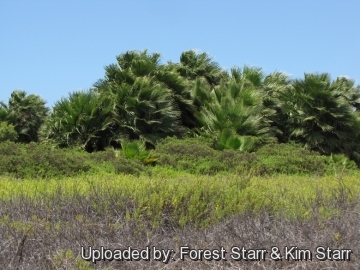 Grove at Kealia Pond NWR, Maui, Hawaii (USA). June 17, 2013. (Washingtonia robusta) Photo by: Forest Starr & Kim Starr
Grove at Kealia Pond NWR, Maui, Hawaii (USA). June 17, 2013. (Washingtonia robusta) Photo by: Forest Starr & Kim Starr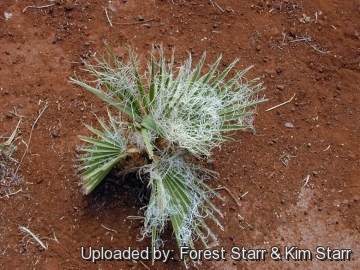 Filiferous seedling at Lahaina, Maui, Hawaii (USA). September 14, 2001. (Washingtonia robusta) Photo by: Forest Starr & Kim Starr
Filiferous seedling at Lahaina, Maui, Hawaii (USA). September 14, 2001. (Washingtonia robusta) Photo by: Forest Starr & Kim Starr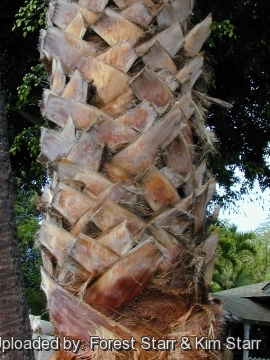 Trunk at Lahaina, Maui, Hawaii (USA). September 14, 2001. (Washingtonia robusta) Photo by: Forest Starr & Kim Starr
Trunk at Lahaina, Maui, Hawaii (USA). September 14, 2001. (Washingtonia robusta) Photo by: Forest Starr & Kim Starr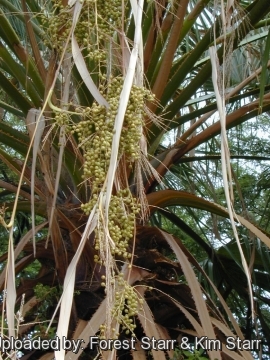 Immature fruits at Lahaina, Maui, Hawaii (USA). September 14, 2001. (Washingtonia robusta) Photo by: Forest Starr & Kim Starr
Immature fruits at Lahaina, Maui, Hawaii (USA). September 14, 2001. (Washingtonia robusta) Photo by: Forest Starr & Kim Starr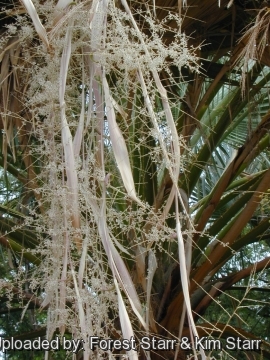 Flower pannicle at Lahaina, Maui, (USA). September 14, 2001. (Washingtonia robusta) Photo by: Forest Starr & Kim Starr
Flower pannicle at Lahaina, Maui, (USA). September 14, 2001. (Washingtonia robusta) Photo by: Forest Starr & Kim Starr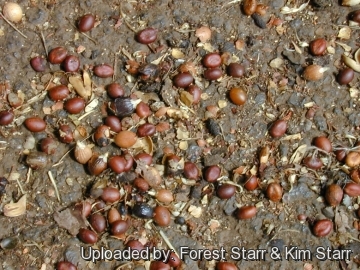 Seeds on ground at Lahaina, Maui, Hawaii (USA). September 14, 2001. (Washingtonia robusta) Photo by: Forest Starr & Kim Starr
Seeds on ground at Lahaina, Maui, Hawaii (USA). September 14, 2001. (Washingtonia robusta) Photo by: Forest Starr & Kim Starr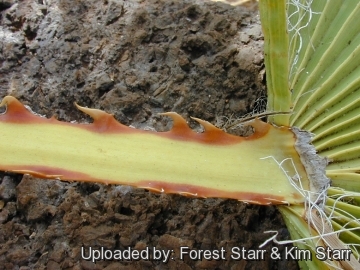 Armed branch at Lahaina, Maui, Hawaii (USA). September 14, 2001. (Washingtonia robusta) Photo by: Forest Starr & Kim Starr
Armed branch at Lahaina, Maui, Hawaii (USA). September 14, 2001. (Washingtonia robusta) Photo by: Forest Starr & Kim StarrCultivation and Propagation: It is a widely grown palms in subtropical climates and a very conspicuous feature of street and ornamental planting in southern California. It is adapted to a Mediterranean climate with cool, moist winters and summer drought. Specimens outside of Mediterranean climates do not grow as large, rarely exceeding 15 metres. This palm is inexpensive, adapts to most soils, is easy to grow and transplant, is very hardy and tolerating neglects.
Soil: It is very adaptable to many kinds of well drained soils: clay; sand; loam; acidic to alkaline. It can even grow in extreme alkaline soils that have a pH as high as 9.2.
Fertilization: It respond very well to fertilizer and need a perfect fertilizer diet including all micro nutrients and trace elements or slow release fertilizer applied during the growing season, or according to package directions, using a fertilizer specifically formulated for palms. As with other palms, potassium and magnesium deficiencies may occur and mineral supplements should be administered in recommended amounts to prevent or treat such deficiencies.
Water Requirements: It tolerates low levels of humidity and summer drought, though it prefers evenly moist but not consistently wet medium. When supplied with adequate moisture and fertilizer it is also fairly fast growing. This palm is very drought tolerant once established. It dislikes soggy or over-irrigated soils because it frequently develops trunk or root rot.
Light: It prefers bright sunny locations and even quite small specimens will thrive in full sun, but it also does well in part shade with some direct sunlight.
Aerosol salt tolerance: It is somewhat salt resistant and may be grown near the sea if given some protection (behind a dune, building, etc.)
Wind resistance: It endures drying winds.
Hardiness: These palms are some of the hardier palms, but somewhat less cold hardy than the California Washingtonia, hardy to about ?7 °C ( USDA Zones 9-11) and established plants have survived, with severe damage to the foliage, brief periods of temperatures as low as ?10 °C. Palms in fast-draining soil are more cold hardy. During the winter, leaves may become temporarily discoloured by damp cold and frost.
Roots: Usually not a problem.
Breakage: resistant.
Transplant: Even large California fan palms can be successfully transplanted.
Maintenance: For the healthiest and most attractive plant, keep the palm pruned. The dead fronds are known to be a fire hazard and a popular bedding roost for rodents and, because of this, must be removed, but in humid and windy climates this is not such a problem as the high winds tend to keep the palms skirt-free. As the old fronds die, these should be trimmed off and the leaf bases allowed to dry out, but do not prune if the frond still has some green colour. Palms recycle nutrients from dead or dying fronds and use them for healthier fronds.
Fruit characteristics: does not attract wildlife; not showy; fruit/leaves not a litter problem.
Pest and diseases: It is quite resistant to pests/diseases and is quite resistant to lethal yellowing disease.
Uses: It is used massively in gardening and landscaping in many parts of the world though in sheltered areas it will survive prolonged periods below freezing point. Plant it outdoors in a site that can accommodate the large head of leaves, and is not directly under power lines or other structures. Use the Mexican fan palm in natural and formal groupings and in large open areas.
It is a striking sight when planted at equal intervals along a boulevard, street without pavement, avenue and parkland planting where it typically is spaced about 9 m apart or when snuggled up in groups against high rise building. It is also excellent in containers and urns. And thanks to its drought resistance and durability to heat it can thrive in harsh urban conditions.
Traditional uses: The fruit of the fan palm was used by Native Americans. It was eaten raw, cooked, or ground into flour for cakes. The Cahuilla and related tribes used the leaves to make sandals, thatch roofs, and for making baskets.
Propagation: By seed. They germinated in less than within 2 months. The seeds are reported to germinate well. Germination is considered so easy that young plants may become weeds under mature palms.

















